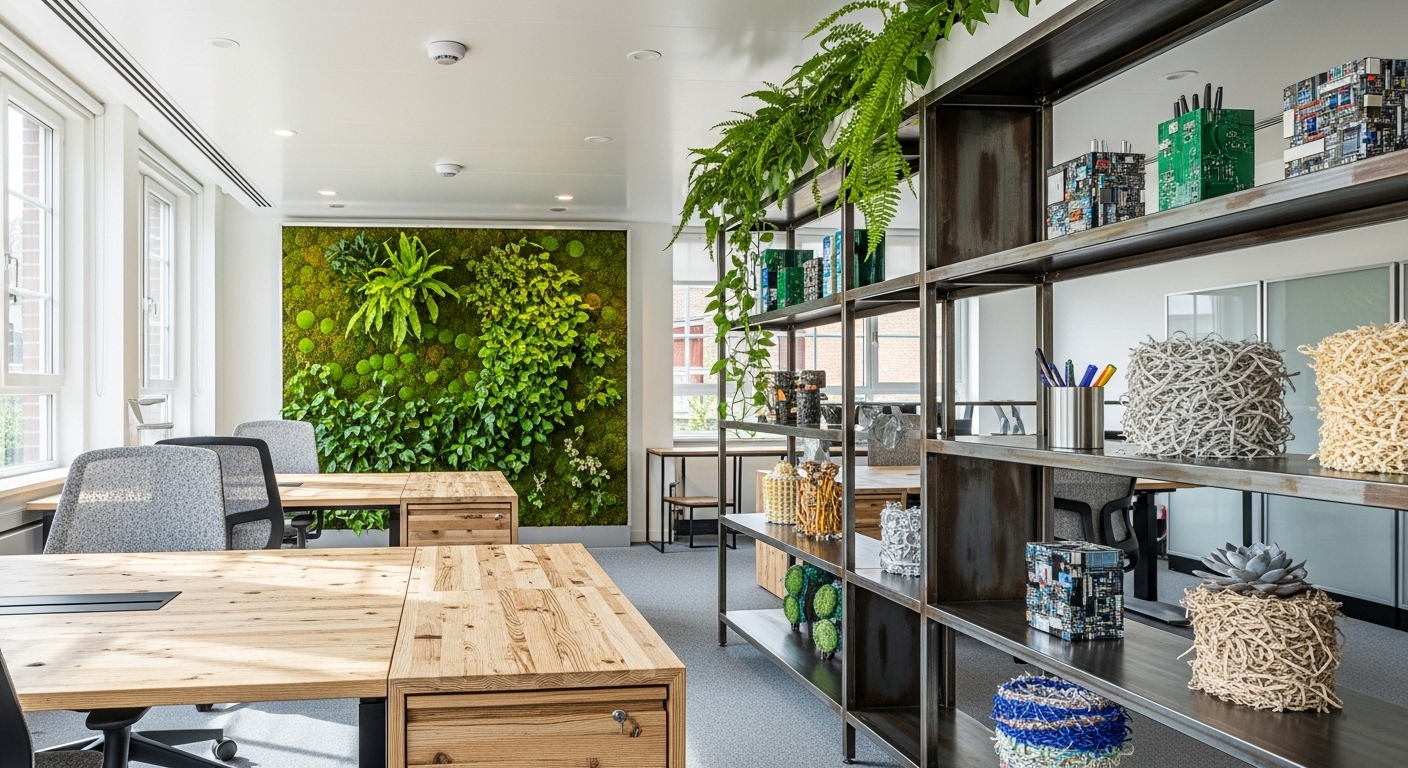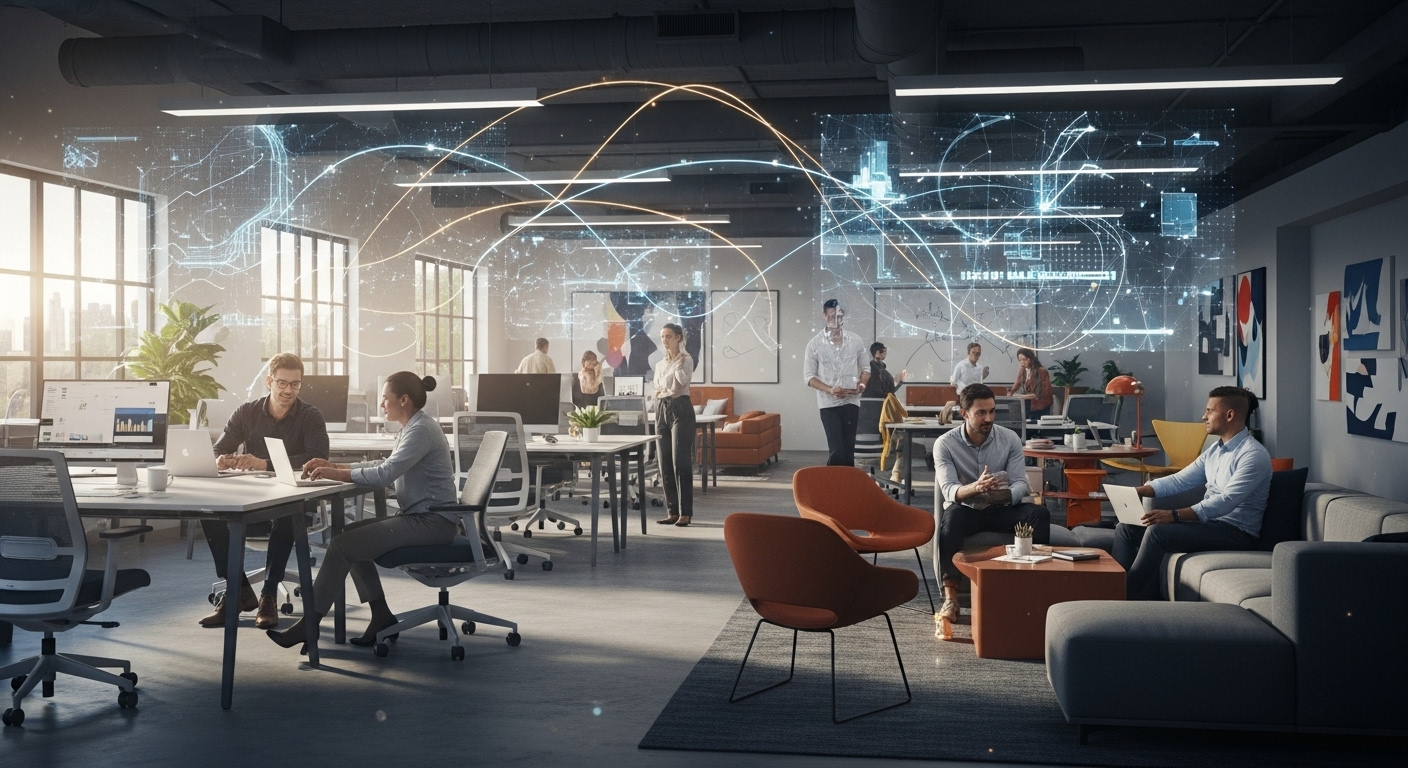In the pursuit of corporate responsibility, the term ‘sustainable workspace’ has often been narrowly defined by energy-efficient light bulbs and recycling bins. While important, these elements only scratch the surface of a much deeper, more impactful strategy. The next frontier in sustainable design lies not just in how we operate our spaces, but in what they are fundamentally made of. Welcome to the material economy of the workplace—a holistic approach that scrutinizes the entire lifecycle of every desk, chair, and carpet tile, from raw material extraction to end-of-life repurposing. This shift moves beyond simple operational efficiency to address the embodied carbon and environmental cost embedded in our physical assets. In a world increasingly driven by ESG (Environmental, Social, and Governance) metrics, understanding the provenance and future of your office materials is no longer a niche interest but a core business imperative. This article will guide you through this new paradigm, exploring how to build a truly sustainable workspace from the supply chain up, focusing on circular design, ethical procurement, and the tangible ROI of a material-centric strategy.
Redefining ‘Green’: Beyond Energy Audits to Material Intelligence
For decades, the sustainability conversation in commercial real estate has been dominated by operational carbon—the emissions produced from heating, cooling, and powering a building. Certifications like LEED and BREEAM have rightfully pushed organizations to optimize energy and water usage. However, this focus overlooks a massive and critical piece of the environmental puzzle: embodied carbon. Embodied carbon refers to the total greenhouse gas emissions generated from manufacturing, transportation, and installation of building materials. For a new building, it can account for up to 75% of its total carbon footprint over its lifetime. This is where the concept of material intelligence becomes paramount. It’s a strategic shift from simply asking ‘How much energy does our office use?’ to ‘What is the true environmental cost of the materials that create this office?’ This deeper inquiry forces a re-evaluation of procurement and design. Instead of defaulting to standard, mass-produced furniture with opaque supply chains, a material-intelligent approach prioritizes transparency. It involves understanding the chemical makeup of products, the labor practices of their manufacturers, and their potential for reuse or recycling. A 2021 report by the World Green Building Council highlighted the urgency of this, stating:
“Addressing upfront carbon is the most effective way to deliver whole life carbon reductions and ensure the building and construction industry can decarbonise by 2050 to meet the goals of the Paris Agreement.”
This means that every choice, from the structural steel to the paint on the walls and the fabric on the chairs, carries a carbon legacy. By shifting focus to the supply chain, businesses can make more informed decisions that drastically reduce their overall environmental impact, transforming the office from a passive consumer of resources into an active participant in a healthier, more sustainable material economy.
The Sourcing Blueprint: Ethical Procurement and Sustainable Materials
Creating a workspace grounded in the material economy begins with a robust sourcing blueprint. This is not merely about finding the cheapest supplier; it’s a forensic exercise in tracing the origins of products and prioritizing those that are healthy, ethical, and regenerative. The first step is to demand transparency from vendors. This involves asking for Environmental Product Declarations (EPDs), which are like nutrition labels for building materials, detailing lifecycle environmental impacts. Similarly, Health Product Declarations (HPDs) disclose material ingredients and potential health hazards. Armed with this data, you can actively avoid materials with high embodied carbon or those containing harmful volatile organic compounds (VOCs) that contribute to poor indoor air quality. The core of the blueprint is the selection of sustainable materials. This includes prioritizing items with high-recycled content, such as acoustic panels made from PET bottles or carpets woven from discarded fishing nets. Another key category is rapidly renewable materials like bamboo, cork, or linoleum, which have shorter harvest cycles than traditional hardwood. Furthermore, championing locally sourced materials not only supports regional economies but also significantly cuts down on transportation-related emissions. For instance, opting for furniture fabricated within a 100-mile radius versus importing it from overseas can have a massive impact. Certifications serve as a vital shorthand in this process. Look for Forest Stewardship Council (FSC) certification for wood products, ensuring they come from responsibly managed forests, and Cradle to Cradle (C2C) certification, which evaluates products on material health, circularity, and social fairness. By codifying these priorities into a formal procurement policy, a business can systematically build a workspace that is not only aesthetically pleasing and functional but also fundamentally aligned with planetary and human health.
Designing for Disassembly: The Principles of a Circular Workspace
The traditional approach to office design follows a linear ‘take-make-waste’ model. Furniture and fittings are installed, used until they break or go out of style, and then sent to a landfill. A circular workspace, however, is designed with the end in mind. This concept, known as Design for Disassembly (DfD), is a revolutionary framework for eliminating waste by ensuring that every component can be easily separated, maintained, repaired, or repurposed. At its core, DfD favors mechanical connections over permanent ones. Think screws and bolts instead of industrial adhesives and welds. This allows a desk, for example, to be taken apart so its wooden top can be refinished and its steel legs can be reused or recycled, rather than discarding the entire unit. Modular design is a key ally of DfD. Using standardized, interlocking components for everything from wall systems to furniture allows for incredible flexibility. As a company’s needs change, the workspace can be reconfigured, expanded, or downsized with minimal waste, akin to a life-sized Lego set. This not only extends the life of the assets but also avoids the immense cost and carbon footprint associated with a full-scale rip-and-replace renovation. Material selection is also critical. Choosing durable, high-quality materials ensures a longer initial lifespan. Furthermore, designers should opt for mono-materials (products made from a single material) where possible, as they are far easier to recycle than complex composites. As Interface, a leader in modular flooring, has demonstrated, designing products for take-back programs and easy separation of components can create a closed-loop system. Their carpet tiles can be returned, stripped of their backing and yarn, and recycled into new products, effectively creating a perpetual resource. By embracing DfD, companies can transform their physical workspace from a static, disposable asset into a dynamic, adaptable resource hub that perpetually retains its value.
The Digital Ledger: Leveraging Technology for Supply Chain Transparency
The principles of a material-centric workspace—transparency, traceability, and circularity—can be powerfully enabled by modern technology. Creating a truly circular system requires knowing exactly what your assets are, where they came from, what they’re made of, and their condition. This is where digital tools like material passports and blockchain come into play, creating an immutable digital ledger for every physical item in the office. A material passport is a digital data set that documents the identity and characteristics of materials in a product or building. It contains information on the origin, manufacturer, maintenance requirements, and disassembly instructions. By scanning a QR code on a chair or desk, a facilities manager can instantly access its entire history and its potential for future use, making repair and responsible disposal radically simpler. Blockchain technology can take this a step further by providing a decentralized, unchangeable record of an asset’s journey through the supply chain. This guarantees the authenticity of claims about a material being ‘recycled’ or ‘ethically sourced.’ This level of verification is becoming crucial for companies needing to report on ESG goals, as it provides auditable proof of their sustainability efforts. Beyond the supply chain, the Internet of Things (IoT) plays a vital role in managing materials once they are in the office. Sensors embedded in furniture and equipment can monitor usage patterns, track asset location, and predict maintenance needs. For instance, a sensor could alert staff that a specific task chair is underutilized and could be moved to a higher-traffic area, optimizing asset use. Or, it could signal that a component is nearing the end of its life, allowing for proactive repair instead of reactive replacement. By integrating these technologies, businesses can create a smart, self-aware environment that not only tracks its own material DNA but also actively works to extend the life and value of every component within it.
From Policy to Practice: Engaging Employees in the Material Lifecycle
A beautifully designed sustainable workspace can only achieve its full potential if the people who use it are active participants in its mission. The most sophisticated circular systems will fail without cultural alignment and employee engagement. Therefore, transforming company policy into daily practice requires a deliberate and continuous effort to educate, empower, and involve staff in the material lifecycle of their office. The process starts with communication. Many employees may not realize that their modular desk is designed for repair, not replacement, or that the office carpeting is part of a take-back recycling program. Use onboarding sessions, internal newsletters, and clear signage to tell the story behind the materials. Explain the ‘why’—how their actions contribute to larger corporate ESG goals and a healthier planet. This fosters a sense of shared ownership and pride in the workspace. Next, empower employees with the right tools and processes. This means making sustainable choices the easy choice. Set up clearly labeled, multi-stream waste stations for recycling, composting, and even specialized items like batteries or e-waste. Create a simple system for reporting broken or worn-out furniture so it can be repaired through the Design for Disassembly principles rather than being hidden or thrown away. Gamification can be a powerful tool for engagement. Launch a ‘Waste Reduction Challenge’ between departments or reward teams that demonstrate the best practices in material stewardship. Recognize ‘Sustainability Champions’ who actively promote circular behaviors. By making it interactive and rewarding, you transform compliance from a chore into a positive cultural activity. Ultimately, this engagement creates a positive feedback loop. When employees are invested in maintaining their environment, assets last longer, waste is reduced, and the financial and environmental benefits of the material-centric approach are amplified, embedding sustainability deep within the company’s operational DNA.
Measuring What Matters: The ROI of a Material-Centric Approach
Investing in a sustainable workspace built from the supply chain up is not an act of corporate charity; it is a shrewd long-term business strategy with a compelling return on investment (ROI). While the initial costs of certified, durable, and ethically sourced materials may sometimes be higher, the financial benefits manifest across multiple areas, far beyond a lower utility bill. The most direct return comes from reduced lifecycle costs. Designing for disassembly and investing in repairable, modular furniture drastically cuts down on replacement expenses. Instead of a costly overhaul every 5-7 years, the office can be adapted and refreshed at a fraction of the cost. Waste management expenses also plummet when circular principles are embraced, as less material is being sent to landfills, which carry ever-increasing tipping fees. A significant, though less direct, financial benefit is talent attraction and retention. In a competitive labor market, a demonstrable commitment to sustainability is a powerful differentiator. A 2021 survey found that nearly two-thirds of millennials, who will comprise 75% of the workforce by 2025, consider a company’s social and environmental commitments when deciding where to work. A workspace that embodies these values becomes a tangible recruiting tool. Brand reputation and client perception are also major factors. Companies with strong, verifiable ESG credentials are more attractive to investors, partners, and customers. A workspace built on material intelligence is a physical manifestation of this commitment. It’s a story you can tell, a tour you can give, proving that your values are not just on paper but are built into the very fabric of your organization. Finally, a healthy material palette directly impacts productivity and well-being. Offices using low-VOC materials and biophilic elements consistently report lower rates of absenteeism and higher cognitive function among employees. This translates directly to the bottom line, turning an investment in healthy materials into an investment in human capital.
The journey toward a truly sustainable workspace requires a fundamental shift in perspective. It demands that we look past the operational outputs and delve into the material inputs that form the foundation of our daily work environments. Moving from a linear, disposable model to a circular, material-conscious one is the single most impactful step a company can take to reduce its environmental footprint. By implementing a sourcing blueprint focused on ethical and sustainable materials, embracing design for disassembly, and leveraging technology for transparency, organizations can create spaces that are not only healthier and more inspiring but also more resilient and cost-effective. This is not about sacrificing quality or aesthetics; it is about elevating them through intelligent, responsible choices. The ROI extends beyond financial metrics to enhanced brand equity, a stronger ability to attract top talent, and a healthier, more engaged workforce. Building a workspace from the supply chain up is to build a legacy—a physical testament to a company’s commitment to people, planet, and long-term prosperity in the future of work.





